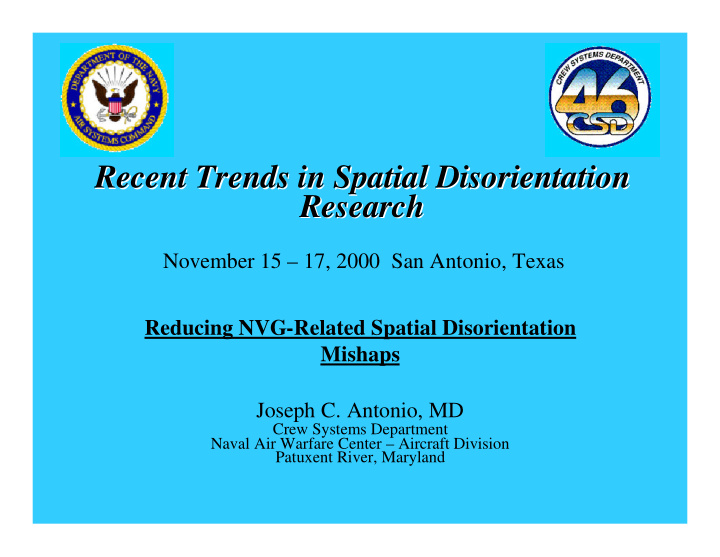



Recent Trends in Spatial Disorientation Recent Trends in Spatial Disorientation Research Research November 15 – 17, 2000 San Antonio, Texas Reducing NVG-Related Spatial Disorientation Mishaps Joseph C. Antonio, MD Crew Systems Department Naval Air Warfare Center – Aircraft Division Patuxent River, Maryland
Introduction Introduction • Purpose – Provide recipe for success in helping decrease NVG-related CFIT mishaps • Disclaimer – Opinions are those of the briefer and do not represent official Navy position
Making Rabbit Stew Making Rabbit Stew What is the first thing to do when making rabbit stew?
Making Rabbit Stew Making Rabbit Stew Find and catch the rabbit.
Reducing NVG- -Related CFIT Related CFIT Reducing NVG Mishaps Mishaps What is the first thing to do when attempting to reduce the occurrence of NVG-related CFIT mishaps?
Reducing NVG- -Related CFIT Related CFIT Reducing NVG Mishaps Mishaps Find the primary cause and provide solutions.
Primary Cause Primary Cause • Factors leading to NVG-related CFIT mishaps – Task saturation – Breakdown of crew coordination – Poor judgment – Complacency – Fatigue – Overconfidence – Training deficiencies – Inexperience • What is culminating event? – Breakdown in instrument crosscheck
Potential Solutions Potential Solutions • Assumptions – Breakdown in instrument crosscheck is the primary cause for NVG-related CFIT mishaps – Use of NVGs increases aircrew workload • Discussion about solutions divided into three topics – Design efforts – Training – Operational tools • May require new thinking in order to provide help before the mishap – Another way of saying that some of the recommendations may be controversial
Design Efforts 1 Design Efforts 1 • Software changes and upgrades (requires early prioritization) – Cursor control – Decision making algorithms • Commonality in crewstation design within platform types – Habit pattern same for each aircraft Layout of instrument panel • – Keep same for left and right seats – Group primary flight instruments to allow for quick scan • HMD design considerations – Poor requirements may lead to added workload – Keep it simple
Design Efforts 2 Design Efforts 2 NVIS interior lighting • – Good lighting design more critical when using NVGs • Instruments scanned quickly • Habit pattern established with previous lighting – Primary flight instrument readability more important than compatibility with NVGs • NVG flight is a heartbeat away from instrument flight • NVIS exterior lighting – Can help with sorting – Improved section/division integrity Improved NVG performance and FOV • – Color – Fusion with other sensors – Improved low light capability
Training Training Introduce NVGs and scan requirements during all phases of • flight training (e.g., primary, basic, etc.) – Easier to establish a pattern than to change one – Determine how “normal” instrument scan differs from scan when using NVGs and train to those differences • Begin NVG flight training during low illumination – Creates the right impression upfront Add SD-inducing profiles to simulator training • – Re-create events leading to previous mishaps – Integrate with regular simulator training sorties • Insure ground, simulation, and flight training correlate to reinforce instrument crosscheck – Training for each typically created in a box. Need to insure effective integration of all modalities.
Operational Tools Operational Tools Realistic guidance for low illumination • – Current value of .0022 lux is not accurate for current NVG technology – Should be based on data agreed to by all parties • Improved tools for preflight planning – Risk management – Current and accurate light level planning calendars • Track experience via event-based data and use a matrix tied to critical experience criteria – NVG flight time is not an accurate indicator of experience • Insure distribution of NVGs is based on mission requirements – Aircrew flying missions requiring enhanced detail (e.g., low illumination masking, low altitude over low contrast terrain, etc.) should have the NVG with the best performance
Summary Summary • NVGs have been in use for a number of years but there are still lessons to be learned. There is no need to wait for the next mishap to take action. Being proactive may result in saved lives and will help win the war of attrition. This may require a new way of looking at the way business is being conducted. • The use of HMDs will lead to some of the same concerns and they should be addressed early in development and not after employment.
Recommend
More recommend